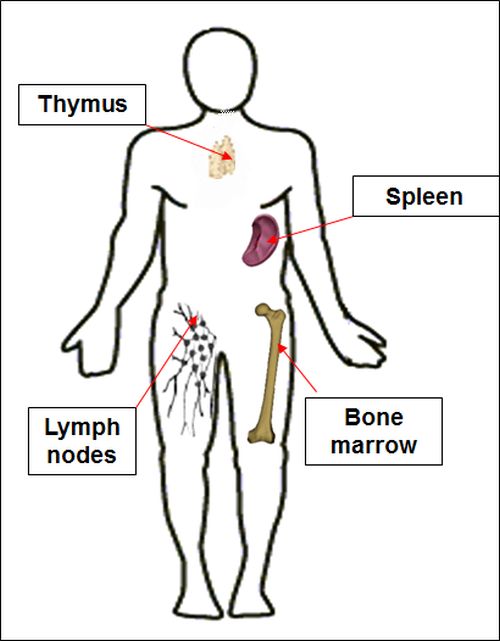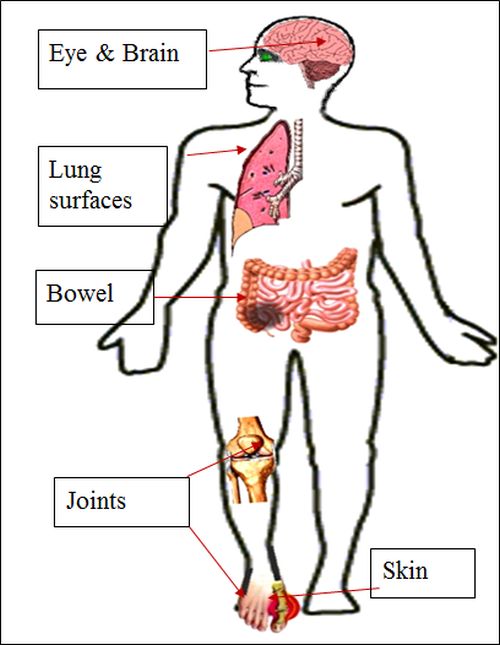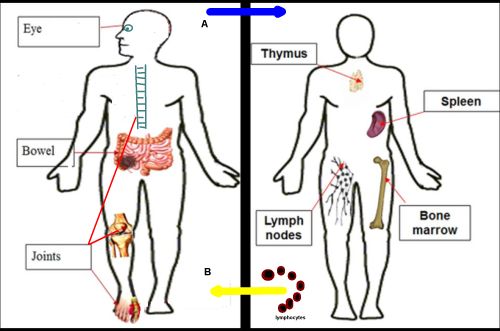HLA-B27 and the Big Picture in AS
Introduction
Historically it was thought that inflammation that was not due to tissue infection was "inflammation against self" or autoimmunity. Hundreds of diseases, including Ankylosing spondylitis (AS) were called autoimmune. This has always been a controversial statement given that autoimmune diseases are commoner in women, but AS is commoner in men. This page shows how knowledge of the entheses and what HLA-B27 may do at the enthesis has changed how doctors classify inflammation against self and understand AS.
Autoimmune Diseases
The immune system has two major, but interlinked aspects, the adaptive and innate arms. Autoimmune Diseases are played caused by abnormalities in adaptive arm. This part of the immune system is housed in the bone marrow, thymus and lymph nodes (including the glands in the neck that painfully swell during infections).
These organs are the home to specialised cells called conventional lymphocytes and include T and B lymphocyte subgroups. These T cells or B cells and their products travel far and wide and can attack completely normal tissues. This is autoimmunity.

|
| the autoimmune diseases are played out in the tissues of the adaptive immune system. These tissues give rise to conventional T and B cells. Antibodies made by the mothers B cells can cross the placenta and induce severe disease in the normal tissues of the newborn baby. |
This part of the immune system is capable of learning and memory and each time it mounts an attack the severity, magnitude of and duration of the attack may be greater.
Innate Immune Disease
The other major arm of immunity is called the innate immune system. This includes tissue barriers to keep germs out. Unfortunately many cases of AS have a defect in the barrier of the bowel.
These barrier and other tissues are patrolled by fast responding cells called macrophages and neutrophils and other cell types too. It is now known that damage to the barriers or abnormalities in these patrolling cells can lead to inflammation against self that is not autoimmune at all. The disease is driven exclusively by the innate immune system which does not have the memory of the adaptive immune system. Scientists term these as "autoinflammatory" diseases to distinguish them from autoimmunity.

|
| Some inflammatory diseases appear to be exclusively dependent on an abnormality in the tissue which becomes inflamed and does not necessarily depend on autoimmune mechanisms. This cartoon shows just some of the organs where the tissue or the innate immune cells resident in the tissue, or both are responsible for disease. |
Key differences between autoimmune and innate immune diseases
In pure autoimmune disease the B and T cells control inflammation and damage. It is the opposite in pure innate immune disease where the target tissue that is inflamed is responsible for controlling the damage. It is now known that AS is a half-way house between the two types of inflammation.
AS - a half-way house Inflammatory Disease
The HLA-B27 related diseases including AS and uveitis are intermediates between innate and adaptive immunity.
The primary problem is in the tissues where an abnormal response to stress or injury at the entheses and adjacent bone triggers activation of the innate immune system. There is also the major issue of the disturbance of the bowel barrier function- another innate immune system problem.
These problems with innate immunity may lead to activation of T cells in the adaptive immune system arm. It is felt that this may lead to the attack being worse at the entheses and bone of HLA-B27 cases.
Since these T cells have memory and since their numbers expand they can then lead to the disease being carried all over the spine and beyond. Since T cells are long lived this can lead to persistent and chronic inflammation.

|
| Tissue specific abnormalities in the joint entheses and bone, the gut or the eye lead to local innate immune activation. This leads to the innate immune system activating the adaptive immune system (blue arrow). This via the HLA-B27 gene activates lymphocytes which then attack the target tissues and lead to more severe or recurrent or persistent inflammation (yellow arrows shows lymphocytes homing from lymphoid tissues to the target tissues). |
Implications
There is a great need to undertake further research into what HLA-B27 is doing in the joint and the eye. Unfortunately, there is no optimism that the HLA-B27 molecule will be "druggable", meaning that companies will not be able to make a compound to block it.
This model of AS offers an explanation for why AS may be more common and more severe in men since they are more likely to have physically demanding jobs that stress the entheses.
Also, although all the evidence strongly points towards T cells being key players in AS the fact remains that this has not been proven in man.
Targeting the innate immune system activation by blocking cytokines has proven very effective in AS. This stops immune activation at the earliest stages. Some modern drugs may actually block both arms of the immune system in AS which could be exciting for even better therapy development.
References


Related Pages on www.enthesis.info
How the Enthesis changed our understanding of the Immune System